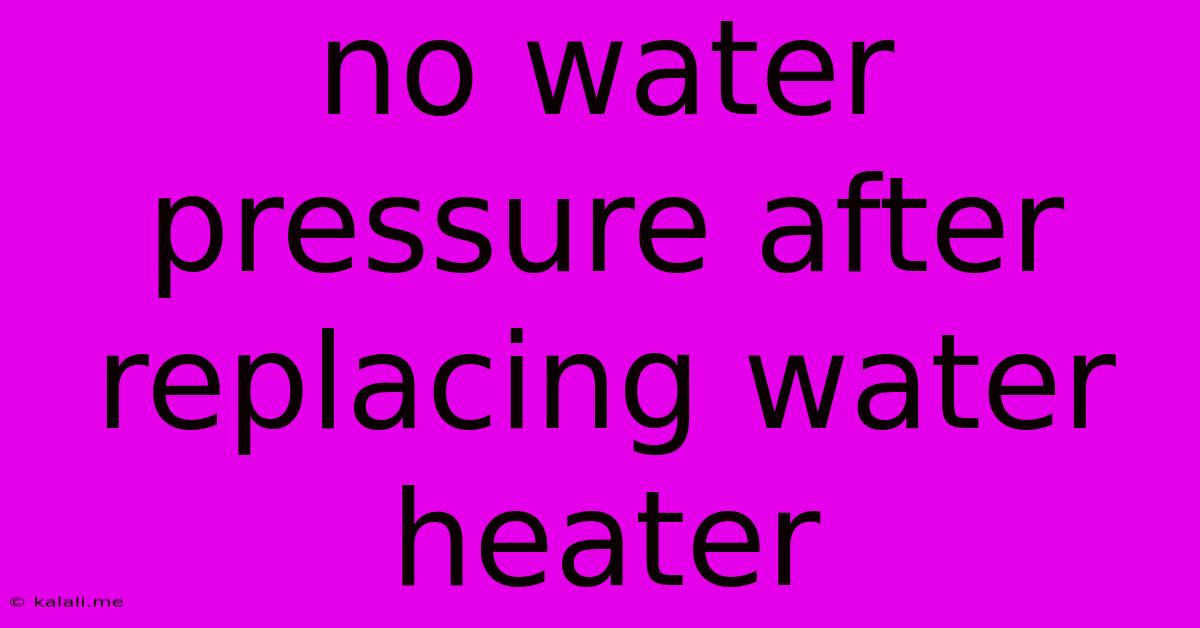No Water Pressure After Replacing Water Heater
Kalali
May 25, 2025 · 3 min read

Table of Contents
No Water Pressure After Replacing Water Heater: Troubleshooting Guide
Have you just replaced your water heater, only to find yourself with significantly reduced or no water pressure? This frustrating issue isn't uncommon, and thankfully, it's often solvable without calling a pricey plumber. This guide will walk you through the most likely culprits and how to troubleshoot them. We'll cover everything from simple checks to more involved fixes, helping you regain full water pressure quickly.
Why is my water pressure low after a water heater replacement? The problem rarely stems from the water heater itself. Instead, the issue usually arises during the installation process, causing disruptions to your plumbing system. Common causes include accidentally blocked pipes, improperly connected valves, or air trapped within the lines.
1. Check the Main Water Shut-off Valve
This is the simplest and often overlooked step. Before you even begin working on the water heater, ensure the main water shut-off valve to your house is fully OPEN. A partially closed or completely closed valve will drastically reduce water pressure throughout your entire home.
2. Examine the Water Heater's Inlet and Outlet Valves
These valves control the flow of water into and out of your water heater. Verify they are both fully open. Sometimes, these valves can be inadvertently closed during installation or may have become slightly jammed. Ensure both are fully turned clockwise (usually meaning "on").
3. Look for Kinks or Clogs in the Supply Lines
Carefully inspect the water supply lines leading to and from your water heater. Look for any kinks or bends that might restrict water flow. Also, check for any debris or sediment that may have become lodged in the lines during the replacement process. A slight kink can significantly impact water pressure. Straighten any kinks gently. If you suspect a clog, you might need a plumber's snake or a specialized tool to clear the obstruction.
4. Bleed Air from the Water Heater
Air trapped within the water heater's plumbing system can significantly reduce water pressure. Most water heaters have a bleed valve – usually a small valve located near the top of the unit. Open this valve slowly, allowing air to escape. You should hear a hissing sound as the air is released. Once a steady stream of water emerges, close the valve.
This process may need to be repeated several times for all the air pockets to be released. You might also want to check other faucets throughout your home to help fully clear the system of trapped air.
5. Inspect the Pressure Relief Valve
The pressure relief valve is a safety device designed to release excess pressure. While rarely the cause of low pressure, a malfunctioning valve can sometimes restrict water flow. Check the valve for any visible damage or leaks. If it's leaking continuously, it might need to be replaced (this should be handled by a qualified plumber).
6. Check Other Fixtures
Is the low water pressure impacting only hot water or also cold water? If it affects both, the problem almost certainly lies outside of your newly installed water heater. This indicates a problem with your main water supply line, requiring professional attention. If the problem only affects hot water after replacing the water heater, you can move onto step 7.
7. Consider Professional Help
If you've checked all of the above and are still experiencing low water pressure after replacing your water heater, it's time to call a qualified plumber. There might be a more complex plumbing issue requiring specialized tools and expertise. This could include a more significant blockage, a problem with the water heater itself (though less likely), or a deeper issue within the home's plumbing system.
By systematically checking these areas, you can often diagnose and resolve the cause of low water pressure yourself. However, remember that safety is paramount. If you're unsure about any step, it's always best to consult a professional plumber. Don't attempt repairs beyond your skill level.
Latest Posts
Latest Posts
-
Wire Size For 60 Amp Breaker
May 25, 2025
-
What To Do With An Abandoned Car
May 25, 2025
-
How To Clean Battery Corrosion From A Flashlight
May 25, 2025
-
How To Watch Hercules And Xena In Order
May 25, 2025
-
Replace Dry Milk In Bread Recipe
May 25, 2025
Related Post
Thank you for visiting our website which covers about No Water Pressure After Replacing Water Heater . We hope the information provided has been useful to you. Feel free to contact us if you have any questions or need further assistance. See you next time and don't miss to bookmark.